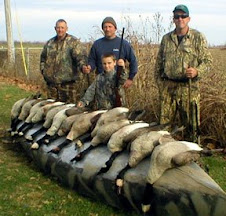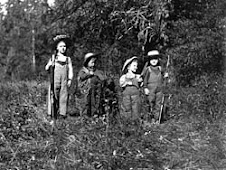For many years, law makers and parents have been the appropriate age for a child to begin hunting. When hunting first became a popular recreational sport, lawmakers decided that it was in the best interest of everyone if children under the age of 18 were not allowed to hunt at all. Yet, as time passed, the regulations kept pushing back the age that children were allowed to hunt. Many parents believe that the children of today have become too lazy, and teaching them to hunt is a good way for them to spend time outdoors, instead of sitting behind a television or computer screen. It is unfair to refuse children under the age of 18 the right to hunt, but it would be equally unfair to let them hunt without restriction. When these restrictions are set in place, it is easier for lawmakers and parents to agree on a solution. Currently in the United States, hunting ages are being altered in 18 states, while thirty states have already lifted the age limit totally (Should Kids Hunt?). The decision of the hunting age is left up to each state government. Yet many governments choose to model themselves after other states, once they see what works (Davidson, 43). According to the Humane Society of the United States, keeping the minimum hunting age so high causes a barrier that is hard for children to deal with and understand. Yet many parents fear that letting children begin hunting too young will impair them for life. “Lowering the hunting age might be a poor decision because it could put children in serious situations that they would not be able to handle” (Remington, 24). However, many people disagree, saying that “hunting, in fact, is the primary--and most humane--instrument of wildlife management in much of the country” (Should Kids Hunt?). In 2005, three organizations—the National Shooting Sports Foundation, the U.S. Sportsmen's Alliance and the National Wild Turkey Federation—started Family Afield, a program designed to get governments to lower the required hunting age.
Children should only be able to hunt with responsible, well-qualified adults. These adults must be at least 21 years of age, and a fully licensed hunter. In many cases, these stipulations are made for children less than 16 years of age. “If the hunting tradition is to continue, it must be passed from one generation to another” (Three Bucks). Many adult hunters want their children to see just how much fun hunting can be, the way it was for them in their childhood. The adult that they hunt with should be an avid hunter, someone who knows the hunting procedures very well. Though many of the children are accompanied by their parents, some children do not have that opportunity. So, some children must have a sponsor who is willing to take them hunting and show them the safe way to participate (Three Bucks).
In many states, children and adults are required to participate in a hunter’s safety course. Upon completion of this course, children who are 14 and older are allowed to hunt alone. “The hunter education course instills in students the knowledge and skill to be a responsible and safe hunter” (Hunter Education). With safety courses like these, students learn how to prevent hunting accidents, understand firearms, know what to do in case of an outdoor emergency, as well as many other things. The classes are open to any age, yet are required for all children ages 12 and under. The Wisconsin Department of Natural Resources does not recommend taking the class until a child is at least 12, the age that children are allowed to have full hunting permits in the state of Wisconsin.
“Wildlife authorities in 26 states are sponsoring youth hunting activities that teach children from eight years old and up how to shoot animals”(State-sponsored youth hunts). Many states are now holding what are called “youth hunting days.”These days are set aside during hunting season just for children. It gives children a chance to learn more of the safety rule, and how to use a firearm properly. The youth Hunting Program in Florida is also a safe way for children to learn to hunt. In order for children to participate, they must be between 12 and 17 years old, and accompanied by a parent. “The Youth Hunting Program of Florida was established to increase the number of youth involved in educational, safe, mentored wildlife and hunting activities through the opportunity to participate in the hunting heritage” (Youth Hunting Program of Florida). Through programs like these, children learn the difference between hunting and conservation, how to hunt ethically, legally, and safely, and develop their firearm skills. When children have days set aside specifically for them to learn how to hunt, they will be able to learn to make wise and safe hunting decisions.
“The number of hunting licenses in the United States dropped to 14.7 million in 2003, from 16.4 million in 1983, according to the federal Fish and Wildlife Service” (Girls and Boys). Many parents feel that this is because the children are more inclined to spend all of their free time inside, rather than enjoying the outdoors. Hunting licenses are actually relatively easy to purchase, but they give the Department of Natural Resources a chance to make sure that the person trying to obtain the license has taken the proper courses. It also gives the opportunity to do a background check on the person who is trying to obtain the license.
Though the debate over what the proper age to begin hunting continues, both the parents and lawmakers agree that certain restrictions should be set in place no matter how old the children are. The decision should not be left up to the parent to decide when the child is ready, and the government should not completely ban children from hunting. Children need to be able to meet the requirements that are being set into place so that the safety of both the children and the people around them will be secure. Evidence and studies have shown that the most appropriate age for a child to begin hunting would be the age of ten (Davidson, 245).
Sources Cited:
Belluck, Pam. "Girls and Boys, Meet Nature. Bring Your Gun." The New York Times (Sept 18, 2005): A1(L). Academic OneFile. Gale. Clemson University. 16 Apr. 2008
Davidson, Tyler. Common Restrictions For Hunting. Utah: University Press, 1980.
Downey, Kevin. "Teaching Kids to Use a Gun.(TSC)(Brief article)." Broadcasting & Cable 138.10 (March 10, 2008): 20. Expanded Academic ASAP. Gale. Clemson University. 16 Apr. 2008
"Fact Sheet:Hunters Targeting Children." Hunting Campaign. 2008. Humane Society of the United States. 14 Apr. 2008
"Hunter Education." 13 Mar. 2007. Wisconson Department of Natural Resources. 15 Apr. 2008
Markarian, Michael. "State-sponsored youth hunts target our nation's children." The Animals' Agenda 15.n1 (Jan-Feb 1995): 18(2). Academic OneFile. Gale. Clemson University. 16 Apr. 2008
Morrow, Lance. "Should Kids Hunt?" Times In Partnership With CNN. 3 Nov. 1998. 8
Apr. 2008 http://www.time.com/time/magazine/article/0,9171,989681-1,00.html.
"Youth Hunting Program of Florida." MyFWC.Com. 2006. Florida Fish and Wildlife Conservation Commission. 12 Apr. 2008
"Recreational License and Permit Requirements." My FWC. 5 Feb. 2008. 8 Apr. 2008
Remington, Tom. "Oklahoma Eases Age Restrictions, Required Hunter Safety." South Carolina HuntingToday 12 (Dec. 2007): 16. 16 Apr. 2008.
Zumbo, Jim. "Three bucks for three girls: passing on the tradition is part of what makes hunting so special." Outdoor Life 199.n6 (June-July 1997): 32(2). Academic OneFile. Gale. Clemson University. 16 Apr. 2008



1 comment:
I still have a hard time piecing together the reasons you present. It still sounds more like an informative report.
"The decision should not be left up to the parent to decide when the child is ready, and the government should not completely ban children from hunting."
If this is what you are proposing then who is to decide? If a child has to pass a class, those are usually mandated by the government.
Just know that when using MLA, you don't need a comma between the author's name and the page number in an in-text citation.
Post a Comment